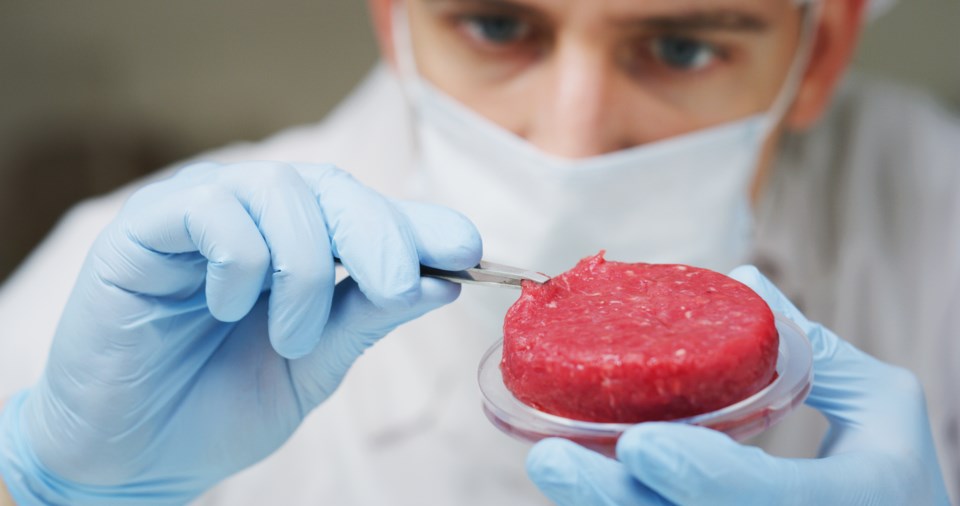The Canadian Cattle Association wants to ensure laboratory-made or cultivated protein won’t be marketed to consumers as meat that is environmentally or nutritionally superior to traditional beef.
The emerging cellular agriculture industry is so new that there are no companies with commercial factories making and selling such products in North America, said Amie Peck, stakeholder engagement manager for the CCA.
“I wouldn’t say at this time we have a real concern.”
However, the association is monitoring the situation to ensure any products are “marketed on their attributes and not on potentially misleading information about environmental footprints or animal welfare,” said Peck.
The CCA’s primary concern is protecting the word “meat” against what Peck described as incorrect labelling once cellular agriculture takes root.
“And so, you’ll hear me say cultivated protein or a lab-made protein because we really hold to the definition of meat being from the flesh of an animal, the carcass of an animal.”
CCA president Nathan Phinney told a recent virtual town hall the association’s food policy committee is shifting its attention toward cellular agriculture.
“We’re looking at regulations and in conversation with stakeholders and government as this product looks to come to market soon.”
The University of Alberta announced Dec. 20 it planned to launch the Institute of Cellular Agriculture to help develop the industry in Canada. Partners in the project included CULT Food Science Corp. and New Harvest, which is a non-profit institute that supports public research into cultured meat.
Officials hoped to expand the initiative into a national network involving other universities and colleges. In a separate announcement Dec. 12, New Harvest said it was collaborating with the Alberta Machine Intelligence Institute (AMII).
The two partners will seek to understand how digital technologies, such as machine learning, could help accelerate the development of cellular agriculture. The project plans to examine how to grow animal cells for fat and organs, as well as meat, said New Harvest executive director Isha Datar during an earlier interview.
Ontario Genomics estimated in 2021 that cellular agriculture could bring as much as $12.5 billion in revenue per year to the Canadian economy, as well as create up to 142,000 jobs.
“I see this as an incredible opportunity for us to become more than just the resource nation, but actually one that’s very focused on the value-adding,” said Datar.
Cellular agriculture will diversify how food is produced without getting rid of livestock-based farming, which will have a role to play in promoting sustainability, she said. For example, animals can be raised in places where crops can’t be grown and vice versa, she added.
Farmers shouldn’t feel threatened by cellular agriculture, said Datar. Creating food from cell cultures grown in bioreactor tanks will complement rather than displace conventional farming by promoting resiliency for food security at a time of increasing disruptions because of climate change, she said.
Peck said the world’s growing population means there’s room for more protein production.
“We really do need all the protein sources we can get, and so there will be a role for cultivated protein to supplement some of that, but we don’t feel at any point it will displace beef production or the role of beef cattle environmentally.”
A recent report of the United Nations’ Intergovernmental Panel on Climate Change named cellular agriculture as a promising way to reduce food-related greenhouse gas emissions. Animal rights activists have also seen it as a way to provide meat without slaughtering animals.
However, conventional agriculture involving the raising of cattle helps preserve native grasslands and wildlife habitat, while promoting carbon sequestration, said Peck.
“All of these other various benefits that come with having beef cattle on the land, you wouldn’t get from a commercial factory.”
The level of greenhouse gas emissions from cultivated protein is uncertain because there are no commercial facilities on which to conduct a lifecycle analysis, said Peck. There is no basis for any claims that it will be inherently more environmentally friendly than conventional beef production, she said.
“Just the construction of these facilities — the concrete that would need to be made — and then these are huge bioreactor tanks that have high energy requirements, so unless they can be powered by solar or wind, they’re probably going to be powered by fossil fuels in the beginning,” she said.
“What does that look like contrasted to the carbon emissions from the beef industry? And until we take this full-picture view, it’s really hard to say what will be more sustainable.”
The other problem facing cultivated proteins is whether they will be as tasty or cheaper for consumers as traditional meat products such as ground beef, said Peck.
“I think when these cultivated protein products come to market, they’re going to continue to be very expensive,” she said.
“And I think you’ll see them as sort of like a tasting experience at a high-end restaurant. So, I think it’s really not going to displace the love of beef for most Canadians because it’s really going to be out of touch and inaccessible for most, especially looking at the inflationary challenges right now.”



